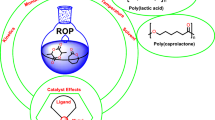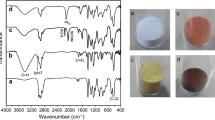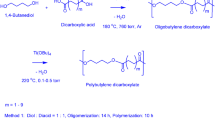Abstract
In this investigation, poly(vinyl alcohol) was chemically modified by the introduction of different amounts of N-phthaloyl-l-phenylalanine. The modification was carried out by the reaction of PVA hydroxyl groups with (2S)-3-phenyl-2-phthalimidylpropanoyl chloride using N,N-dimethyl acetamide/lithium chloride as a reaction media. The novel copolymers obtained were characterized by spectroscopic techniques, elemental analysis, X-ray diffraction and thermal methods. Optical rotation and viscosities were also measured. The degree of esterification was determined by 1H-NMR. The influence of reagent molar ratio on the degree of modification was also evaluated. The vinyl(3-phenyl-2-phthalimidopropanoate) content in the copolymer was attained up to 52%. Thermal stability of the copolymers was checked by thermogravimetric analysis and differential thermogravimetric analysis. All copolymers displayed improved thermal stability compared to the parent polymer.







Similar content being viewed by others
References
Aoi K, Takasu A, Okada M (1997) New chitin-based polymer hybrids. 2. improved miscibility of chitin derivatives having monodisperse poly(2-methyl-2-oxazoline) side chains with poly(vinyl chloride) and poly(vinyl alcohol). Macromolecules 30:6134–6138
Aoi K, Takasu A, Okada M (2000) DNA-based polymer hybrids Part 1. Compatibility and physical properties of poly(vinyl alcohol)/DNA sodium salt blend. Polymer 41:2847–2853
Baudrion F, Perichaud A, Coen S (1998) Chemical modification of hydroxyl functions: introduction of hydrolyzable ester function and bactericidal quaternary ammonium groups. J Appl Polym Sci 70:2657–2666
Bose AK, Greer F, Price CC (1958) A procedure for phthaloylation under mild conditions. J Org Chem 23:1335–1338
Bruzaud S, Levesque G (2000) Synthesis and characterization of new functional polymers by polymer-analog reactions on EVOH copolymer. Macromol Chem Phys 201:1758–1764
Chetri P, Dass NN, Sarma NS (2006) Synthesis of poly(vinyl propionate) from poly(vinyl alcohol) in nonaqueous medium using ethyl nitrate dimethyl sulfoxide as a catalyst. J Appl Polym Sci 102:5675–5679
Chiellini E, Corti A, Antone SD, Solaro R (2003) Biodegradation of poly (vinyl alcohol) based materials. Prog Polym Sci 28:963–1014
Cimenez V, Mantecon A, Cadiz V (1996) Modification of poly(vinyl alcohol) with acid chlorides and crosslinking with difunctional hardeners. J Polym Sci A Polym Chem 34:925–934
Ciminez V, Mantecon A, Cadiz V (1996) Crosslinking of poly(viny1 alcohol) using dianhydrides as hardeners. J Appl Polym Sci 59:425–431
Corti A, Roberto S, Chiellini E (2002) Biodegradation of poly(vinyl alcohol) in selected mixed microbial culture and relevant culture filtrate. Polym Degrad Stab 75:447–458
Dhaon MK, Olsen RK, Ramasamy K (1982) Esterification of N-protected α-amino acids with alcohol/carbodiimide/4-(dimethylamino)-pyridine. Racemization of aspartic and glutamic acid derivatives. J Org Chem 47:1962–1965
Dumitriu CL, Popa M, Savin A, Sunel V, Pintilie O, Craciun R, Popa AA (2006) Polymer-biologically active principle conjugates obtained by esterification of poly(vinyl alcohol). Polym Plast Technol Eng 45:481–486
Fernandez MD, Fernandez MJ (2008) Cyclic ureas as solvents for esterification of poly(vinyl alcohol) and vinyl acetate-vinyl alcohol copolymers with acid chlorides. J Appl Polym Sci 107:2509–2519
Gacal BN, Koz B, Gacal B, Kiskan B, Erdogan M, Yagci Y (2009) Pyrene functional poly(vinyl alcohol) by ‘‘Click’’ chemistry. J Polym Sci A Polym Chem 47:1317–1326
Ghorai MK, Das K, Kumar A (2007) A convenient synthetic route to enantiopure N-tosylazetidines from α-amino acids. Tetrahedron Lett 48:2471–2475
Gimenez V, Reina JA, Mantecon A, Cadiz V (1999) Unsaturated modified poly(vinyl alcohol) crosslinking through double bonds. Polymer 40:2759–2767
Goiti E, Salinas MM, Arias G, Puglia D, Kenny JM, Mijangos C (2007) Effect of magnetic nanoparticles on the thermal properties of some hydrogels. Polym Degrad Stab 92:2198–2205
Goodship V, Jacobs D (2005) Polyvinyl alcohol: materials processing and applications. Smithers rapra technology, UK
Ibrahim MM, El-Zawawy WK, Nassar MA (2010) Synthesis and characterization of polyvinyl alcohol/nanospherical cellulose particle films. Carbohydr Polym 79:694–699
Jayasekara R, Harding I, Bowater I, Christie GBY, Lonergan GT (2004) Preparation, surface modification and characterisation of solution cast starch PVA blended films. Polym Test 23:17–27
Luo Z, Li B, Fang X, Hu K, Wu X, Fu E (2007) Novel chiral solvating agents derived from natural amino acid: enantiodiscrimination for chiral α-arylalkylamines. Tetrahedron Lett 48:1753–1756
Mallakpour S, Asadi P (2010) Novel chiral poly(ester-imide)s with different natural amino acids in the main chain as well as in the side chain: synthesis and characterization. Colloid Polym Sci 288:1341–1349
Mallakpour S, Dinari M (2009) Soluble new optically active polyamides derived from 5-(4-methyl-2-phthalimidylpentanoylamino)isophthalic acid and different diisocyanates onder microwave irradiation in molten ionic liquid. J Appl Polym Sci 112:244–253
Mallakpour S, Khani M (2010) Construction of chiral polyesters from polycondensation of multifunctional monomer containing both flexible amino acid and rigid pendant groups with aromatic diols. Amino Acids 39:841–848
Mallakpour S, Mirkarimi F (2010) Synthesis and characterization of novel, optically active polyamides derived from S-valine natural amino acid and bulky anthracenic side chain. Amino Acids. doi:10.1007/s00726-010-0560-0
Mallakpour S, Rafiee Z (2008a) Use of ionic liquid and microwave irradiation as a convenient, rapid and eco-friendly method for synthesis of novel optically active and thermally stable aromatic polyamides containing N-phthaloyl-l-alanine pendent group. Polym Degrad Stab 93:753–759
Mallakpour S, Rafiee Z (2008b) Safe and fast polyamidation of 5-[4-(2-phthalimidiylpropanoylamino)-benzoylamino]isophthalic acid with aromatic diamines in ionic liquid under microwave irradiation. Polymer 49:3007–3013
Mallakpour S, Rafiee Z (2009) Microwave-induced synthesis of new optically active and soluble polyamides containing pendent 4-(2-phthalimidiylpropanoylamino)benzoylamino-groups. Amino Acids 37:665–672
Mallakpour S, Sepehri S (2008) Polycondensation of new optically active diacid with diisocyanates in the presence of tetrabutylammonium bromide as a green media under microwave heating. React Funct Polym 68:1459–1466
Mallakpour S, Taghavi M (2008) A facile, microwave-assisted synthesis of novel optically active polyamides derived from 5-(3-methyl-2-phthalimidylpentanoylamino) isophthalic acid and different diisocyanates. Eur Polym J 44:87–97
Mallakpour SE, Hajipour AR, Khoee S, Sheikholeslami B (1998) A new method for producing optically active polybutadiene. Polym Int 47:193–197
Mallakpour SE, Hajipour AR, Mahdavian AR, Khoee S (1999a) Asymmetric polymerization via cycloaddition reactions. J Polym Sci A Polym Chem 37:1211–1219
Mallakpour SE, Hajipour AR, Mahdavian AR, Rafiemanzelat F (1999b) Highly diastereoselective synthesis of novel polymers via tandem Diels-Alder-ene reactions. Polym Int 48:109.116
Mallakpour S, Tirgir F, Sabzalian MR (2010a) Synthesis and structural characterization of novel biologically active and thermally stable poly(ester-imide)s containing different natural amino acids linkages. J Polym Res. doi:10.1007/s10965-010-9427-z
Mallakpour S, Tirgir F, Sabzalian MR (2010b) Novel biobased polyurethanes synthesized from nontoxic phenolic diol containing l-tyrosine moiety under green media. J Polym Environ 18:685–695
Mallakpour S, Tirgir F, Sabzalian MR (2010c) Synthesis, characterization and in vitro antimicrobial and biodegradability study of pseudo-poly(amino acid)s derived from N,N-(pyromellitoyl)-bis-l-tyrosine dimethyl ester as a chiral bioactive diphenolic monomer. Amino Acids. doi:10.1007/s00726-010-0686-0
Martensa P, Hollandb T, Anseth KS (2002) Synthesis and characterization of degradable hydrogels formed from acrylate modified poly(vinyl alcohol) macromers. Polymer 43:6093–6100
Nishiot Y, John Manley RS (1988) Cellulose/poly(vinyl alcohol) blends prepared from solutions in N,N-dimethylacetamide-lithium chloride. Macromolecules 21:1270–1277
Ohgi H, Sato T (2002) Highly isotactic poly(vinyl alcohol). III: hetrogenous cationic polymerization of tert-butyl vinyl ether. Polym commun 43:3829–3836
Orienti I, Bigucci F, Gentilomi G, Zecchi V (2001) Self-assembling poly(vinyl alcohol) derivatives, interactions with drugs and control of release. J Pharm Sci 90:1435–1444
Peng Z, Kong LX (2007) A thermal degradation mechanism of polyvinyl alcohol/silica nanocomposites. Polym Degrad Stab 92:1061–1071
Saha N, Sedlarik V, Saha P (2005) Electromagnetic properties of aluminosilicate-filled polymer composites of poly(vinyl alcohol)-poly(vinyl pyrrolidone). Polym Compos 26:739–744
Sahmetlioglu E, Yuruk H, Toppare L, Cianga I, Yagci Y (2004) Synthesis and characterization of conducting copolymers of poly(vinyl alcohol) with thiophene side-groups and pyrrole. Polym Int 53:2138–2144
Sedlarik V, Saha N, Kuritka I, Saha P (2006) Characterization of polymeric biocomposite based on poly(vinyl alcohol) and poly(vinyl pyrrolidone). Polym Compos 27:147–152
Sedlarık V, Saha N, Kuritka I, Saha P (2007) Environmentally friendly biocomposites based on waste of the dairy industry and poly(vinyl alcohol). J Appl Polym Sci 106:1869–1879
Takasu A, Aoi K, Tsuchiya M, Okada M (1999) New chitin-based polymer hybrids, 4: soil burial degradation behavior of poly(vinyl alcohol)/chitin derivative miscible blends. J Appl Polym Sci 73:1171–1179
Takasu A, Itou H, Takada M (2003) Accelerated biodegradation of poly(vinyl alcohol) by a glycosidation of hydroxyl groups. Polymer 43:227–231
Thomas LV, Arun U, Remya S, Nair PD (2009) A biodegradable and biocompatible PVA- itric acid polyester with potential applications as matrix for vascular tissue engineering. J Mater Sci Mater Med 20:259–269
Tosh B, Saikai CN, Dass NN (1999) Development of a nonaqueous solvent system for poly(vinyl alcohol) and its characterization. J Appl Polym Sci 74:663–669
Utracki LA (2004) Clay-containing polymeric nanocomposites. Rapra technology limited, UK
Wu TK, Ovenal DW (1973) Proton and carbon-13 nuclear magnetic resonance studies of poly(viny1 alcohol). Macromolecules 6:582–584
Yang JM, Wang HZ, Yang CC (2008) Modification and characterization of semi-crystalline poly(vinyl alcohol) with interpenetrating poly(acrylic acid) by UV radiation method for alkaline solid polymer electrolytes membrane. J Membr Sci 322:74–80
Zeng Q, Liu Z, Li B, Wang F (2004) Mild and effective N-phthaloylation of amino acids. Amino Acids 27:183–186
Zhai M, Yoshii F, Kume T, Hashim K (2002) Synthesis of PVA/starch grafted hydrogels by irradiation. Carbohydr Polym 50:295–303
Acknowledgments
We wish to express our gratitude to the Research Affairs Division Isfahan University of Technology (IUT), Isfahan, for partial financial support. Further financial support from National Elite Foundation (NEF) and Center of Excellency in Sensors and Green Chemistry Research (IUT) is gratefully acknowledged. We also like to thank Mr. M. Hatami and Mr. M. Dinari for their valuable help.
Author information
Authors and Affiliations
Corresponding author
Rights and permissions
About this article
Cite this article
Mallakpour, S., Barati, A. Preparation and characterization of novel optically active poly(vinyl alcohol-co-vinyl ester) in nonaqueous medium using l-phenylalanine as a chiral material. Amino Acids 42, 1287–1295 (2012). https://doi.org/10.1007/s00726-010-0823-9
Received:
Accepted:
Published:
Issue Date:
DOI: https://doi.org/10.1007/s00726-010-0823-9




